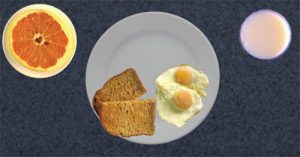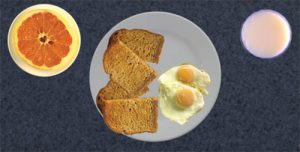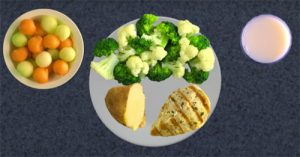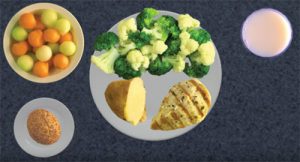Bulletin #4363, Dining with Diabetes: Meal Planning Using the Plate Method
Bulletin #4363, Dining with Diabetes: Meal Planning Using the Plate Method (PDF)
Developed by Alan Majka, Associate Extension Professor/Educator, University of Maine Cooperative Extension.
Reviewed by Kate Yerxa, Associate Extension Professor, University of Maine Cooperative Extension.
For information about UMaine Extension programs and resources, visit extension.umaine.edu.
Find more of our publications and books at extension.umaine.edu/publications/.
There are many ways someone with prediabetes or type 2 diabetes may plan meals. Some methods are very complicated, and other methods focus only on a single aspect of the meal, such as carbohydrate counting to control blood sugar. To simplify diabetes meal planning and address the whole diet, the Idaho Plate Method was created. The plate method became the basis for the Dining with Diabetes program used by Cooperative Extension programs in many states, including UMaine Extension’s Dining with Diabetes Down East. The plate method is similar to USDA’s MyPlate; however, it places greater emphasis on limiting carbohydrates in order to control blood sugar.
There are six steps to follow when using the plate method. The following information in this publication is also available as a video series.
Step 1. Use the right size dishes
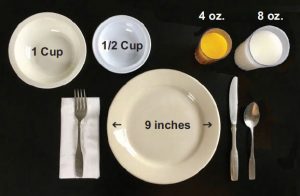 Researchers have found the plates, bowls, cups, and glasses we use have a strong influence on how much we eat and drink. If you use dishes that are too big, you tend to eat too much. Using smaller dishes means you don’t need to weigh and measure all of your food and beverages.
Researchers have found the plates, bowls, cups, and glasses we use have a strong influence on how much we eat and drink. If you use dishes that are too big, you tend to eat too much. Using smaller dishes means you don’t need to weigh and measure all of your food and beverages.
When serving meals, you will need the following:
- A plate that measures 9 inches across. Sometimes these are called luncheon plates.
- A bowl that holds 8 fluid ounces, or 1 cup.
- A dish that holds 4 fluid ounces, or ½ cup.
- A drinking glass or cup that holds 8 fluid ounces, or 1 cup.
- A juice glass that holds 4 fluid ounces, or ½ cup.
Using the correct size dishes is an easy way to control portion sizes.
Step 2. When serving meals, cover the top half of your 9-inch plate with low carbohydrate vegetables.
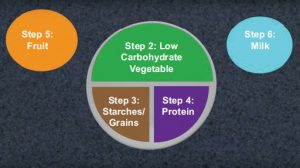 Most vegetables are low in carbohydrates so they don’t have much effect on blood sugar. They also tend to be low in calories and rich in nutrients, and help you to feel full without gaining weight. Rather than covering the top half of your plate with a single low carbohydrate vegetable, meals are more appealing and nutritious when you include a colorful variety of at least two different kinds of vegetables in a meal. Low carbohydrate vegetables may be fresh, frozen or canned. Canned vegetables may be placed in a colander and rinsed with water before cooking to reduce sodium. Avoid vegetables that are processed with fat, sodium or sugar-containing sauces. Think about ways to include more low carbohydrate vegetables in your day such as adding them to your breakfast and snacks.
Most vegetables are low in carbohydrates so they don’t have much effect on blood sugar. They also tend to be low in calories and rich in nutrients, and help you to feel full without gaining weight. Rather than covering the top half of your plate with a single low carbohydrate vegetable, meals are more appealing and nutritious when you include a colorful variety of at least two different kinds of vegetables in a meal. Low carbohydrate vegetables may be fresh, frozen or canned. Canned vegetables may be placed in a colander and rinsed with water before cooking to reduce sodium. Avoid vegetables that are processed with fat, sodium or sugar-containing sauces. Think about ways to include more low carbohydrate vegetables in your day such as adding them to your breakfast and snacks.
Low carbohydrate vegetables include:
- Artichokes
- Asparagus
- Beets
- Broccoli
- Brussels sprouts
- Cabbage
- Carrots
- Cauliflower
- Celery
- Cucumbers
- Fiddleheads
- Greens: turnip, mustard, kale
- Green beans
- Leeks
- Mushrooms
- Okra
- Onions
- Pea pods
- Peppers
- Radishes
- Salad Greens: lettuce, endive, romaine
- Spinach
- Summer squash like yellow crookneck
- Tomatoes
- Turnips
- Water chestnuts
- Zucchini
Step 3. When serving meals, cover the bottom left quarter of your plate with starchy vegetables or grains.
Starchy vegetables, grains, and foods made from grains provide important nutrients. They also contain carbohydrates. Too much carbohydrate eaten at once may cause blood sugar to rise too high.
When choosing foods made from grains, try to select those made with whole grains. For example, wheat products like bread or pasta should have whole wheat listed at the beginning of the ingredients list. Just because a label has the words multi grain or wheat on it, or the product is brown in color, doesn’t mean it’s whole grain. In fact, some whole wheat products are white.
Starchy vegetables and grains include:
- Corn or hominy
- Peas
- Potatoes: white, sweet, or yams
- Winter squash like acorn or butternut
- Dry Beans/Peas: cooked navy, pinto, lima beans, garbanzo, and lentils
- Bagel, ½ small
- Biscuit, 1 small
- Bread, 1 slice
- Cereal Cold, 8-fluid-ounce bowl
- Cereal Hot, 4-fluid-ounce dish
- Crackers
- Granola bar, small
- Grits
- Hamburger or hot dog bun, 1/2
- Muffin, small
- Pasta or noodles
- Pancakes, two 4-inch diameter
- Rice, preferably brown
- Roll, small
- Soup, 1 cup
- Tortilla, small
Step 4. When serving your meals, fill the bottom right quarter of your plate with meat or other protein foods.
Protein foods provide nutrients that are important to health with little or no carbohydrate that can impact blood sugar. Some of these foods may, however, be high in calories and contain saturated fats that can increase blood levels of bad cholesterol. The recommended 3-ounce serving of cooked meat, poultry or fish is about the size of a deck of cards and fills one quarter of the 9-inch plate. About four ounces of raw meat, poultry or fish cooks down to about a 3-ounce serving.

Meat and protein foods include:
- Beef, preferably lean
- Cheese, 2 ounces, preferably low fat
- Chicken, preferably without skin
- Eggs, 2
- Fish
- Nuts
- Peanut butter, 2 Tablespoons
- Pork, preferably lean
- Shellfish
- Seeds, sunflower, sesame, pumpkin, etc.
- Tofu
- Turkey, preferably without skin
- Venison
Step 5. When serving your meals, include the correct amount of fruit.
Fruits are another important source of nutrients that contain carbohydrate. A serving of whole fruit is about the size of a tennis ball. Fruit may be fresh, frozen or canned in juice. Fruit canned in light or heavy syrup may be placed in a colander and rinsed with water to remove added sugar. Whole fruit is better than juice.

Select a whole piece or fill a small 4-fluid-ounce dish with:
- Apple
- Apricot
- Banana, ½
- Cherries
- Fruit cocktail
- Grapes
- Grapefruit, ½
- Kiwi
- Mango, ½
- Nectarine
- Orange
- Peach
- Pear
- Pineapple
- Plums
- Prunes
- Tangerine
Or fill 8-fluid-ounce bowl with:
- Blueberries
- Cantaloupe
- Honeydew Melon
- Raspberries
- Strawberries
- Watermelon
Or fill a 4-fluid-ounce glass with 100% no sugar added fruit juice.
Step 6. When serving your meals, include the correct amount of milk or milk products.
Milk and some milk products are good sources of many nutrients; however, they also contain carbohydrates. You probably noticed that cheese was included with the meats and other protein rich foods. This is because cheese tends to have fewer carbohydrates and more saturated fat. If you have difficulties digesting milk due to lactose intolerance, you may still be able to drink a smaller serving without problems. You can also get all the benefits of milk by selecting lactose-free milk. Yogurt and kefir usually contain less lactose than milk.
Fill an 8-fluid-ounce glass with:
- Milk (Fat-free skim or 1% low fat)
Or fill a 4-fluid-ounce dish with:
- Yogurt (plain or artificially sweetened)
- Pudding (sugar-free and fat-free, occasionally)
- Light ice cream or frozen yogurt (sugar-free, occasionally)
Example Meals
- Example of breakfast for a woman.
- Example of breakfast for a man.
- Example of lunch or dinner for a woman.
- Example of lunch or dinner for a man.
Note: Since men tend to have more lean body mass than women, men may add one additional serving of either a starchy vegetable, grain, fruit or milk to each meal.
Information in this publication is provided purely for educational purposes. No responsibility is assumed for any problems associated with the use of products or services mentioned. No endorsement of products or companies is intended, nor is criticism of unnamed products or companies implied.
© 2018
Call 800.287.0274 (in Maine), or 207.581.3188, for information on publications and program offerings from University of Maine Cooperative Extension, or visit extension.umaine.edu.
The University of Maine is an EEO/AA employer, and does not discriminate on the grounds of race, color, religion, sex, sexual orientation, transgender status, gender expression, national origin, citizenship status, age, disability, genetic information or veteran’s status in employment, education, and all other programs and activities. The following person has been designated to handle inquiries regarding non-discrimination policies: Director of Equal Opportunity, 101 Boudreau Hall, University of Maine, Orono, ME 04469-5754, 207.581.1226, TTY 711 (Maine Relay System).


